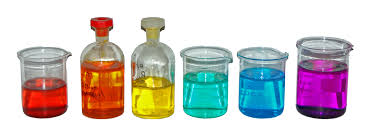Overview
The transition metals occupy a large area on the periodic table. They all appear to have similar metallic properties, because of the way their electron shells are filled. Many transition metals form brightly colored compounds, especially in solution. The transition metal group includes common elements such as iron (Fe), copper (Cu), nickel (Ni), gold (Au), and silver (Ag).
The Periodic Table and Transition Metals
Transition metals are also called transition elements. They are in Groups 3B through 2B, or 3 -12 of the periodic table, occupying the space between the alkali earth metals on the left and the true metals on the right. They are a very large group of 38 elements. Also, chemists usually consider the elements in the lanthanide and actinide series as inner transition elements. There are so many of them that they are usually in a special configuration under the main periodic table.
Properties of Transition Metals
Transition metals are usually solids (except for mercury which is liquid at room temperature), often with high melting and boiling points. They are shiny, metallic, dense, and are often excellent conductors of both heat and electricity. Some transition metals, such as gold and platinum, do not react easily with oxygen, so they resist oxidation, while iron, another transition metal, rusts easily. Technically, transition metals are in the d-block of the periodic table.
Compounds
By definition, transition metals form various types of compounds by giving up different numbers of electrons from their incomplete d shells. For example, sometimes iron gives up 2 electrons and sometimes it gives up 3 when it is oxidized. Trace amounts of transition metals in compounds color paint pigments. Traces of iron color citrine yellow and jade green, and traces of chromium color rubies red. Some of the most unusual colors are caused when transition metals are dissolved in liquid (aqueous) solution.
Types of Transition Metals
The 38 elements include some of the most well-known metals. For example, iron (Fe) is the fourth most abundant element in the Earth’s crust and one of the most widely used in manufacturing. Since pure iron is a soft metal, it is usually alloyed with other elements to make it harder, often as steel. Iron is also essential to life, as it is contained in hemoglobin for vertebrates and in plant cells. Copper (Cu) is used in electrical wiring, as it is one of the best conductors, in alloys such as bronze, and even in copper pipes. Nickel (Ni) is used in alloys, especially with iron, in coins, and is essential to life in some enzymes. The transition metals are also excellent catalysts.
Interested in science tutoring services? Learn more about how we are assisting thousands of students each academic year.
SchoolTutoring Academy is the premier educational services company for K-12 and college students. We offer tutoring programs for students in K-12, AP classes, and college. To learn more about how we help parents and students in Atlantic City, NJ visit: Tutoring in Atlantic City, NJ




